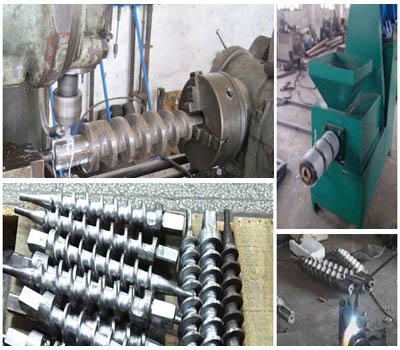Propeller of briquette machine determines its efficiency
The propeller of briquette machine determines the efficiency of briquetting. It is an important factor in determining the efficiency and the forming effect of briquette machine. When purchasing the briquette machine, we need to consider of the quality of propeller seriously. In the following content, we would explain the vital functions of propeller in the forming process of briquette machine.

The briquette machine has multiple functions, it can be used to process a variety of materials. The main briquette machines being sold on the market at present are type 50 and 80. When the propeller is in high-speed rotation, friction is generated due to the contact between the top part of propeller and the raw material, which would lead to serious wear to the end surface of propeller. When the angle of end surface gets smaller or the contact surface becomes rough and spotty, briquettes produced by the briquette machine can not up to the requirements. Serious wear of the propeller would make the briquette produced with small density and not firm. In this case, wear resistance electrode can not be used immediately to weld the propeller. The operator should use the common electrode to weld the prototype of propeller and polish it, and then use the wear-resistant electrode for welding. When choosing the propeller of briquette machine, we should consider the material of propeller first. Propeller produced by ball bearing steel with whole chip production through high-frequency quenching and actual effect heat treatment has higher wear-resisting coefficient and good toughness that avoids damage to the propeller caused by metal hard material in the briquette machine.
Generally speaking, a qualified briquette machine should be operated by skilled personnel so as to produce qualified briquettes. Then, what is the key technology in briquette production? According to the theory and practice, the repair of screw propeller is the key to the production of qualified briquettes. The operator should not only master the relation between the density of briquette and the pressure and temperature, but also learn how to change the front elevation of propeller to adjust the pressure of briquette to produce high density briquette without any crack. Typically, grooves or spot holes would appear on the surface of propeller due to the high temperature friction of the front propeller with materials and its elevation will be reduced. Then, the operator should take down the propeller for examination, and if the inclined plane of the front end is found serious rough and the angle becomes smaller, high iron alloy electrode should be used for welding. Weld repairing should be made according to the technical requirements, and pay attention to slope angle. If there is a stop in the welding, the welding slag must be removed, otherwise it would influence the welding and repair quality. After welding, it should be cooled to ensure its wear resistance. Then, polish the propeller with silicon carbide grinding wheel to meet the requirements.

